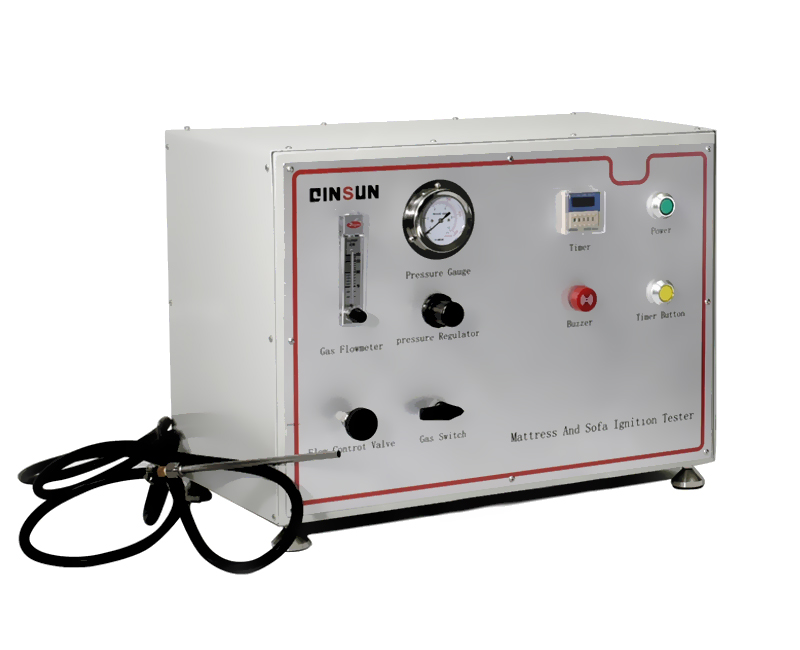Combustion test machine
The combustion tester is specifically designed to test the flexural strength of plug leads and electrical wires. The test method involves securing the specimen to a fixture and applying a specific load. During the test, the fixture swings left and right. After a certain number of swings, the wire breakage rate is checked; if power is lost, the total number of swings is checked. The combustion tester automatically counts and stops operation when the specimen bends to the point of wire breakage and power is lost. The combustion tester consists of a split test section and a control section, facilitating on-site installation and commissioning. The casing and key components of the combustion tester are constructed of stainless steel, resistant to smoke and gas corrosion. The control system features a highly automated control system with a digital time display, convenient observation and recording, and stable and reliable operation.Basic Principles
A vertical combustion tester is primarily used to evaluate the vertical combustion performance of materials. The basic principle is to place a sample in a specific position and ignite one end to observe and record the flame spread. During the test, the tester simulates a real-world fire environment and monitors the sample's reaction to the flame, including indicators such as flame spread rate, burning duration, and smoke production.
This test typically uses standardized test samples to ensure consistent testing conditions. The testing equipment precisely controls the heat source, flame stability, and combustion environment, ensuring scientific and accurate test results. This data not only reflects the flammability of the material but also provides important reference for evaluating the fire safety performance of building materials, household appliances, and other products.
Workflow
The vertical combustion tester workflow typically includes the following steps:
Sample Preparation: Select a sample of appropriate size, cut it, and position it according to the test standard (such as UL-94).
Ignition: Ignite the fire source using a gas or electrical source and place it vertically at the bottom of the sample. Combustion Testing: After ignition, the flame spread is observed, and the burning time and distance of the flame are recorded.
Data Recording and Analysis: Sensors on the equipment record combustion-related data, such as flame spread rate and smoke density, and evaluate the material's combustion performance based on the experimental results.
The accuracy and repeatability of this process are critical to ensuring the credibility of the test results.
Technical Features
Precision Control System: Modern vertical burning testers utilize advanced control systems that precisely adjust test environment parameters such as temperature, humidity, and airflow, ensuring consistent and controllable experimental conditions.
Highly Sensitive Sensors: Equipped with highly sensitive temperature sensors and smoke detectors, the equipment monitors changes in the sample during combustion in real time, providing more accurate test data.
Standardized Testing Capabilities: The vertical burning tester strictly adheres to international and industry standards, such as UL94 and ISO 1210, enabling comprehensive combustion performance evaluation of different types of materials.
Data Recording and Analysis: The equipment automatically records all key parameters during the experiment and generates detailed test reports for subsequent data analysis and verification.
Maintenance
1. Cleaning and Maintenance: Regularly clean the exterior and interior components of the tester, including the combustion chamber, thermocouples, and gas lines. Keep the equipment clean to prevent dust and debris from affecting test results.
2. Check the Power and Gas Source: Ensure the power and gas supply to the tester is functioning properly. Regularly check the power cord and gas lines for integrity. Replace any damaged or deteriorating components promptly.
3. Check the Thermocouple: The thermocouple is a critical component of the tester, used to measure temperature. Regularly check the thermocouple connection for tightness, looseness, or damage. Replace any abnormalities promptly.
4. Check the Gas Supply: Ensure the gas supply to the tester is stable and that the flow and pressure meet the requirements. Regularly check the gas lines for leaks and repair any leaks promptly.
5. Check the Combustion Chamber: The combustion chamber is the core component of the tester, used to simulate the sample combustion process. Regularly check the interior of the combustion chamber for cleanliness and the presence of carbon deposits or debris. Clean if necessary.
6. Check the Control System: The control system of the combustion tester is critical to ensuring test accuracy. Regularly check the control system's circuit boards, sensors, and other components for proper function and damage. Repair or replace any abnormalities promptly.
7. Regular Calibration: To ensure accurate test results, it is recommended to calibrate the testing machine regularly. Calibration should be performed according to the manufacturer's calibration procedures to ensure accurate results.
8. Recordkeeping and Maintenance Logs: Create and maintain a maintenance log for the testing machine, documenting each maintenance and inspection. This helps track the equipment's maintenance history and identify potential issues promptly.



 在线客服
在线客服